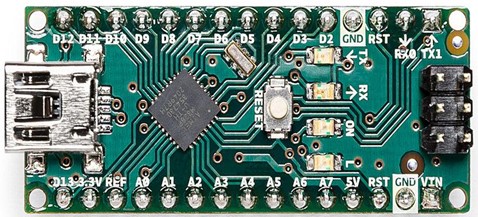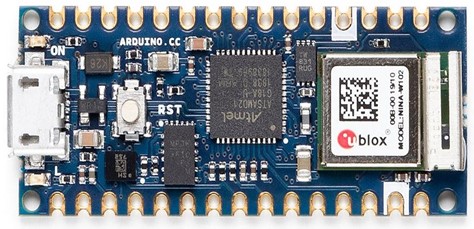Arduino Nano and Arduino Nano 33 IoT are microcontroller boards developed by Arduino. They are included in the Arduino Nano series. The major difference lies in the word IoT. The Arduino Nano does not support wireless connectivity with IoT devices, whereas Arduino Nano 33 IoT does. This article will explore further differences between them.
Arduino Nano
Arduino Nano is a development board by Arduino that is used for faster prototyping because it is breadboard-friendly. It has pin headers that easily fit in the breadboard. It is the oldest board in the Arduino Nano family. It can easily be programmed using a mini USB cable.

Arduino Nano 33 IoT
The Arduino Nano 33 IoT is a miniature device that supports Wi-Fi, Bluetooth, and IoT devices. It has highly secure and advanced features. It is an up-to-date device that can be used to control IoT devices remotely.
Differences Between Arduino Nano and Arduino Nano 33 IoT
There are multiple differences between Arduino Nano and Arduino Nano 33 IoT including microcontrollers, microprocessors programming, sensors, input-output pins, Wi-Fi, Bluetooth support, and others.
Microcontroller and Microprocessor
The Arduino Nano 33 IoT uses a SAMD21 Cortex-M0+ 32-bit low-power ARM MCU microprocessor chip that is very advanced and of high quality. It also had a Nina W102 Module, which is a dual-core Tensilica LX6 microprocessor. On the other hand, Arduino Nano uses the traditional ATMega328 microcontroller.
Clock Frequency
The clock frequency of Arduino Nano 33 IoT is almost three times higher than Arduino Nano. The clock frequency of Arduino Nano 33 IoT is 48MHz, whereas that of Arduino Nano is 18MHz.
Input Output Pins
The Arduino Nano 33 IoT has 8 analog input pins and one analog output pin. The number of digital pins for Arduino Nano 33 IoT is 14 out of which 11 can be used for PWM. In the case of Arduino Nano, the number of analog input-output pins is 8 whereas digital input-output pins are 22. Out of these 22 pins, six can be used for Pulse Width Modulation.
Memory
The microprocessor on Arduino Nano 33 IoT has a CPU flash memory of 256 KB and SRAM of 32 KB. It also has an additional Nina W102 uBlox module that has 448 KB ROM, 520 KB SRAM, and a 2 MB flash. On the other hand, the Arduino Nano has a flash memory of 32KB from which 2 KB is utilized by Bootloader. It consists of 2 KB SRAM and 1 KB EEPROM.
Programming
To program, Arduino Nano connects to the PC through a mini USB cable. It is programmed through Arduino IDE. In the case of Arduino Nano 33 IoT, as it supports wireless connectivity; therefore, it can be programmed using multiple methods. Code can be uploaded to it through Arduino IDE, Arduino Web Editor, Arduino IoT Cloud, and Arduino CLI.
Communication
The Arduino Nano 33 IoT has UART, I2C, and SPI pins for serial communication. Furthermore, it has Wi-Fi and Bluetooth support for wireless connectivity. Contrastively, Arduino Nano, neither has I2C, UART pins nor Wi-Fi and Bluetooth support. It simply has two pins RX and TX that can be used for serial communication.
Wi-Fi and Bluetooth Support
The Arduino Nano 33 IoT has IEEE 802.11 b/g/n Wi-Fi, Bluetooth BR/EDR, and Bluetooth LE module based on ESP32. Both the Wi-Fi and Bluetooth of Arduino Nano 33 IoT have an operating frequency of 2.4GHz. The Arduino Nano does not have any of these features.
Sensors
The Arduino Nano 33 IoT has an additional feature of supporting gyroscope and accelerometer sensors. A sensor chip LSM6DSL is present on the board that has a 6-axis Inertial Measurement Unit (IMU) that operates a gyroscope and accelerometer. The Arduino Nano does not have any of these sensors.
Voltage and Current Ratings
The Arduino Nano has an operating voltage of 5V and the rated voltage between 7V to 12V, and it can handle currents up to 40mA. On the other hand, Arduino Nano 33 IoT operates at 3.3V; however, a chip MPM3610 (DC-DC) on the Nina module of Arduino Nano 33 IoT regulates input voltage from up to 21V. The pins of the Arduino Nano 33 IoT can bear a current of up to 7mA.
Applications
The Arduino Nano can easily interface sensors with it. It has low power consumption and high-quality performance. Therefore, it can be used in security devices such as fingerprint sensors and glass break sensors. It can also be used in Robotics and remote IoT projects.
The Arduino Nano 33 IoT, due to its wireless connectivity feature, can be used in weather stations, air quality monitors, and climate change IoT applications.
Conclusion
The Arduino Nano 33 IoT is an advanced board in the Arduino Nano series. Its capability to connect over the cloud makes it outstanding among others. It can be more easily used in the present connected world; however, Arduino Nano has its own specific uses that are also valuable.

